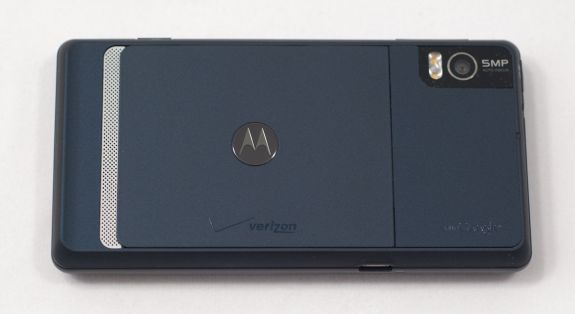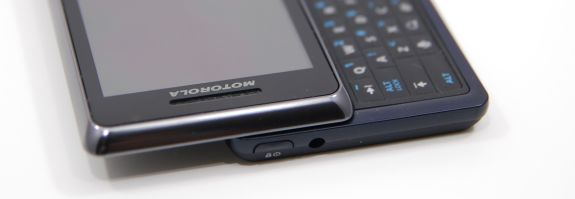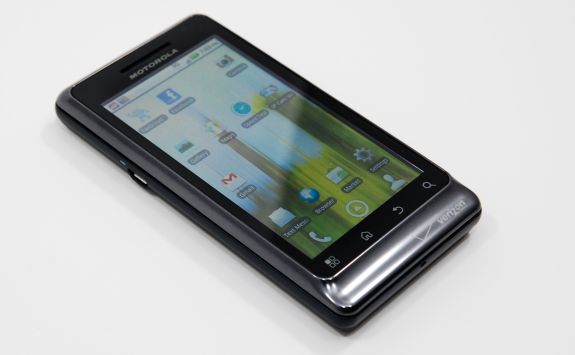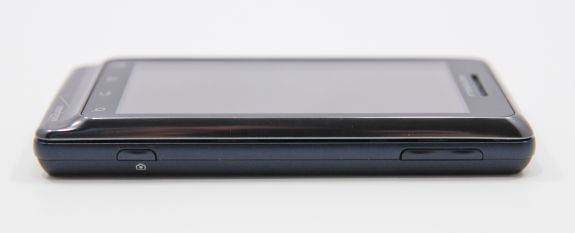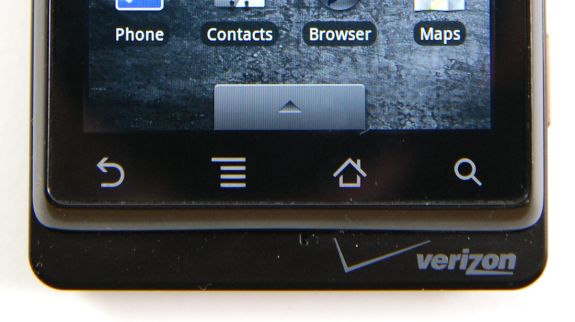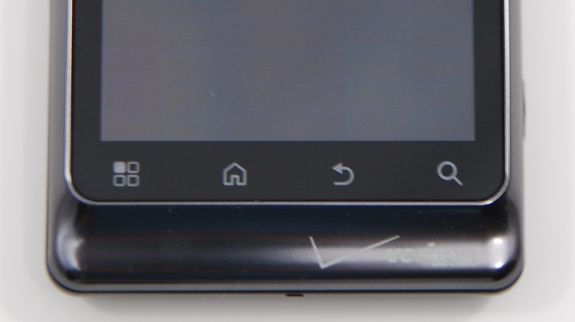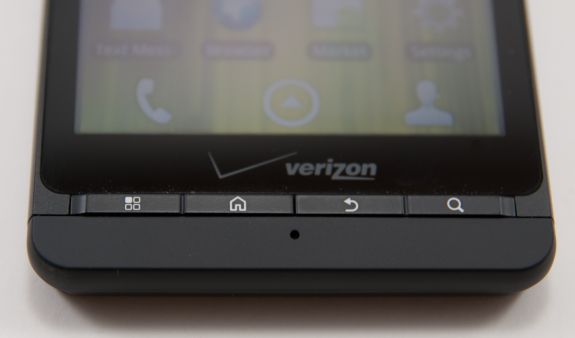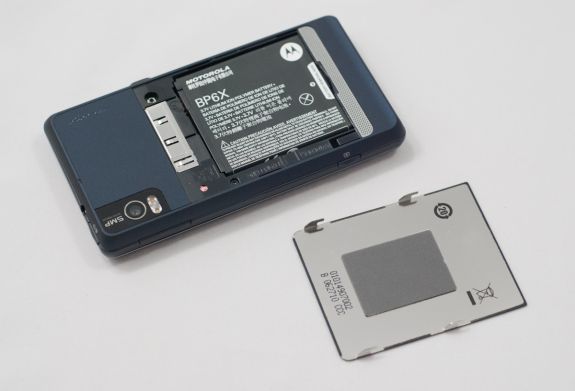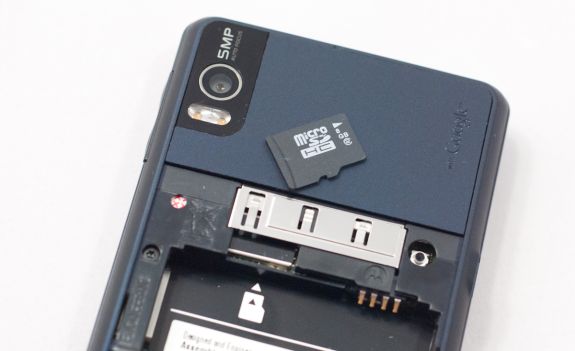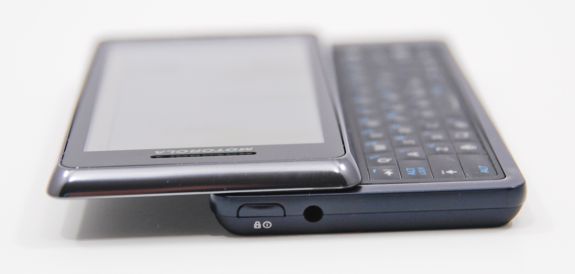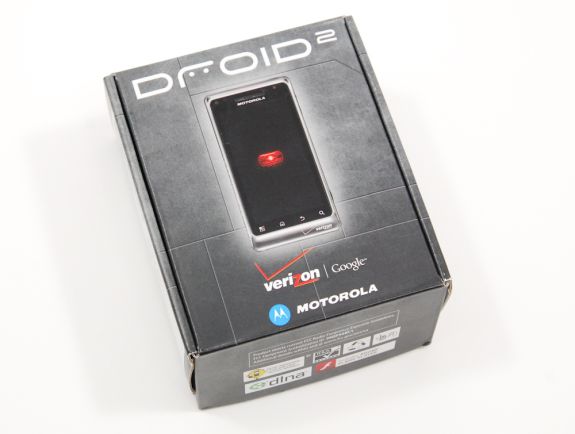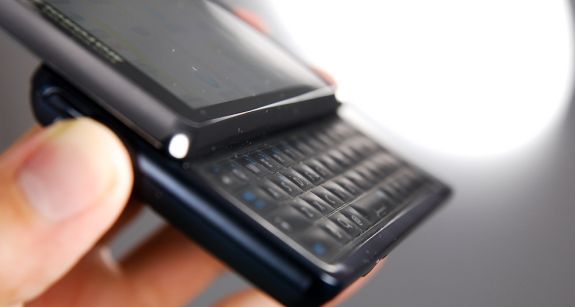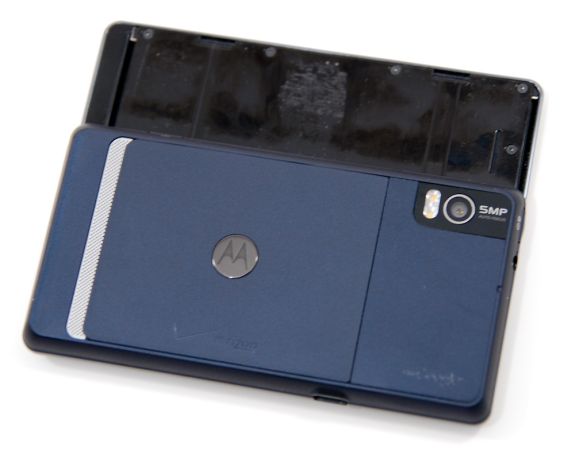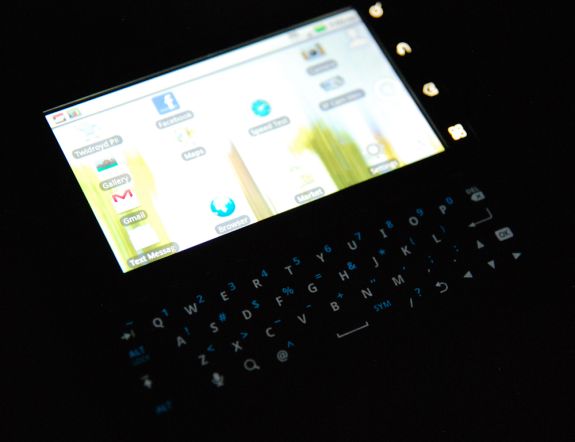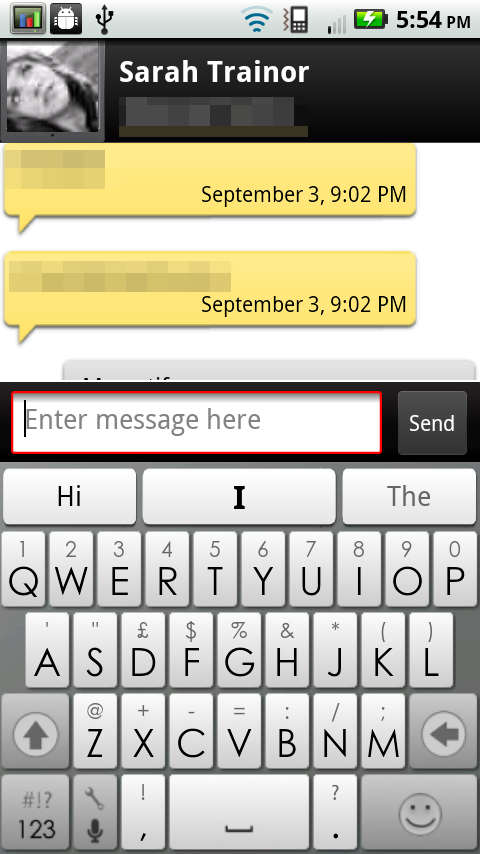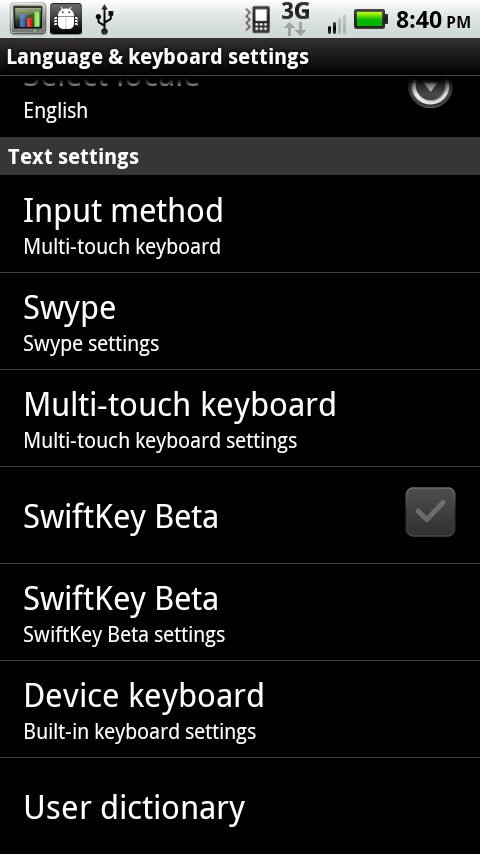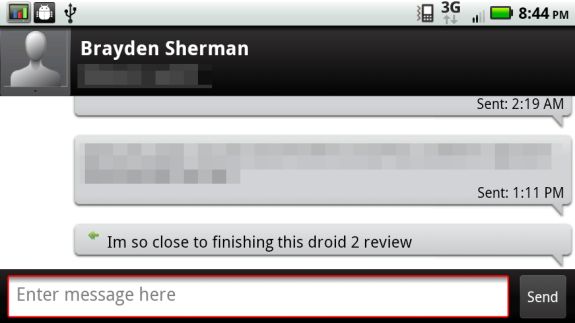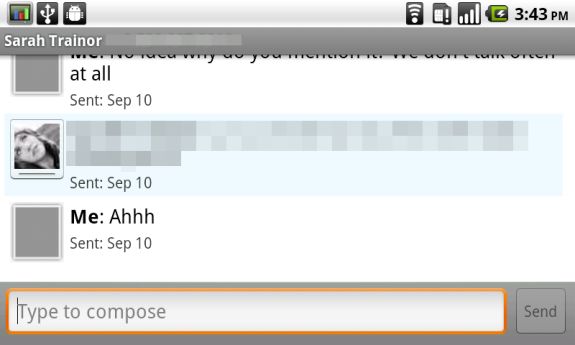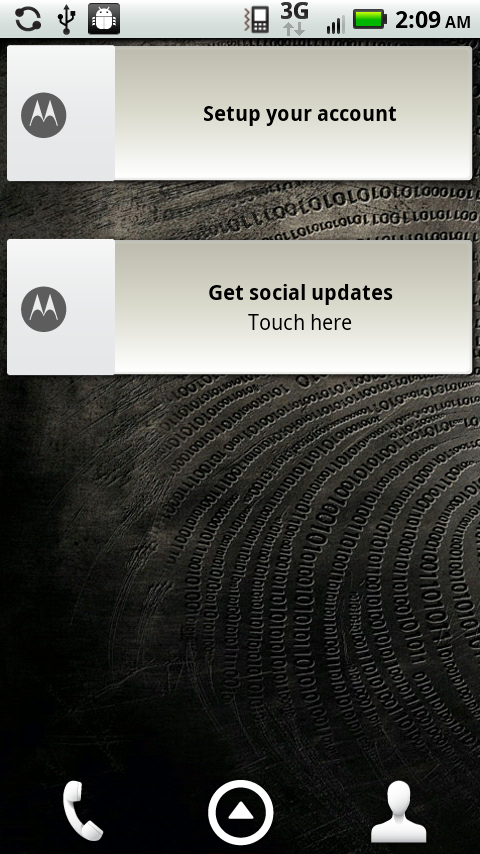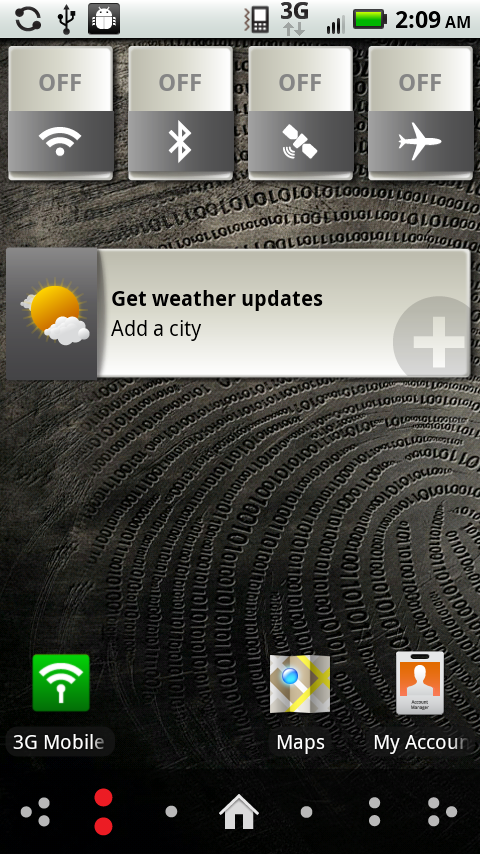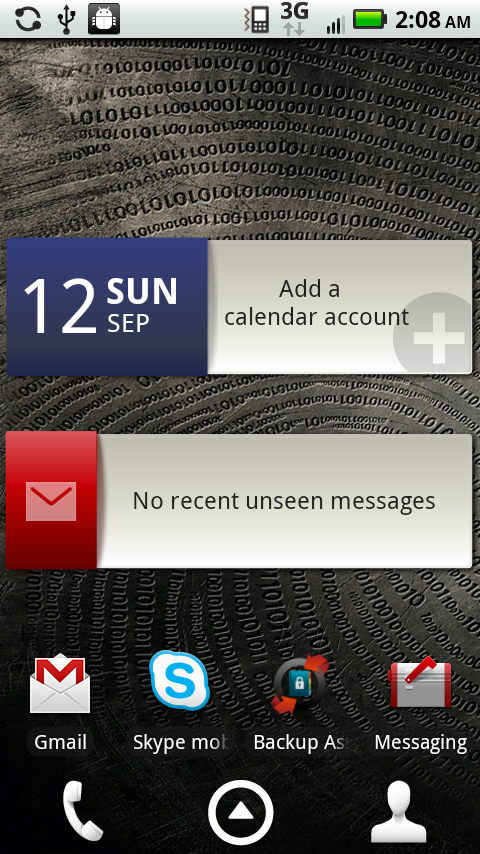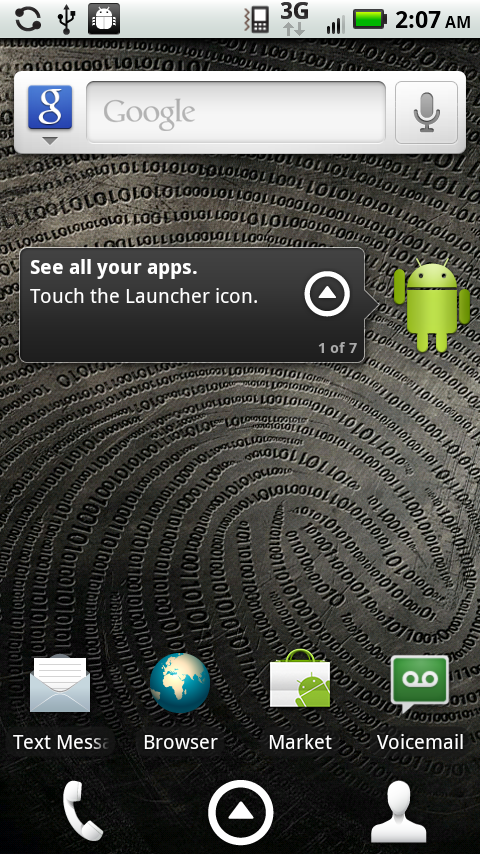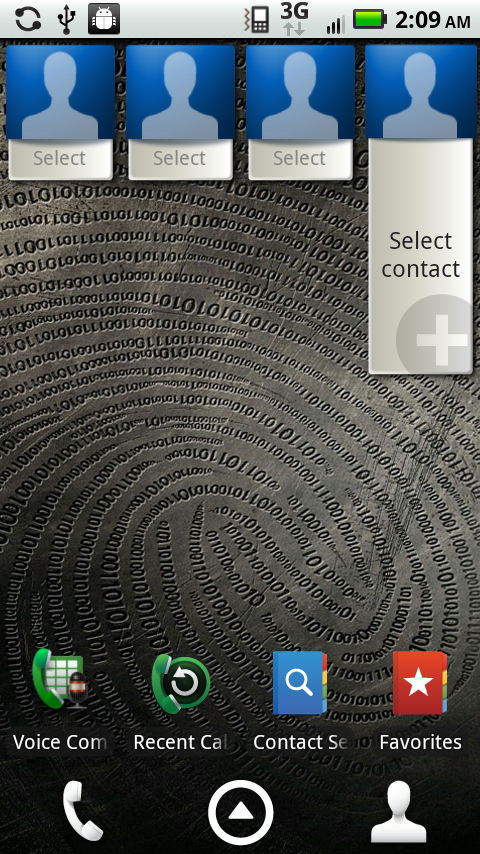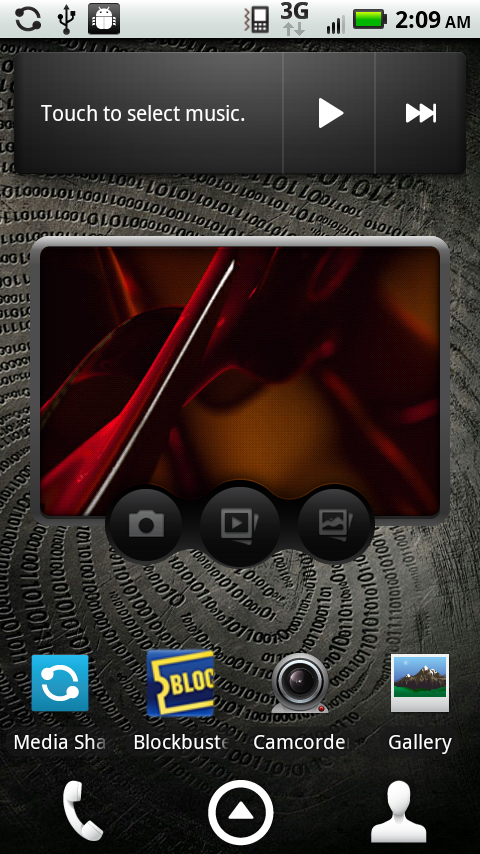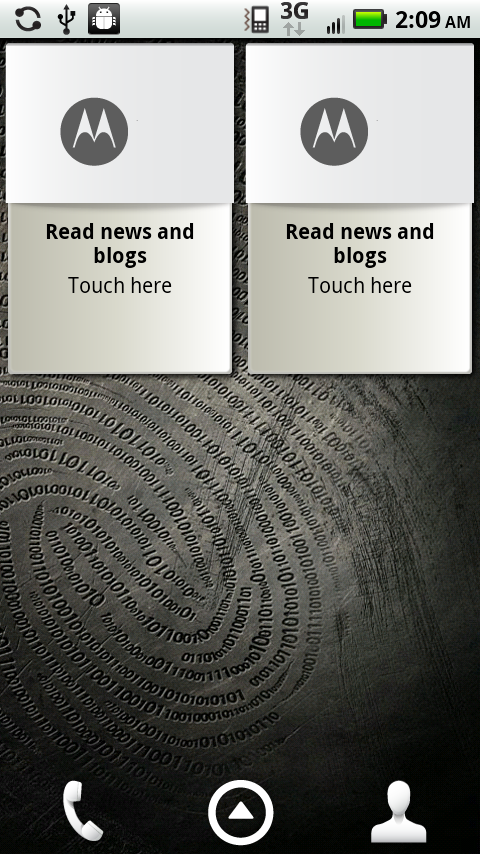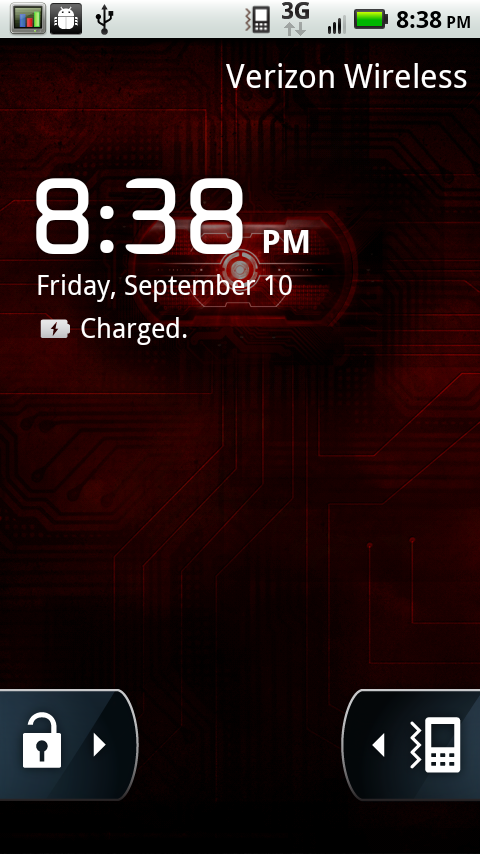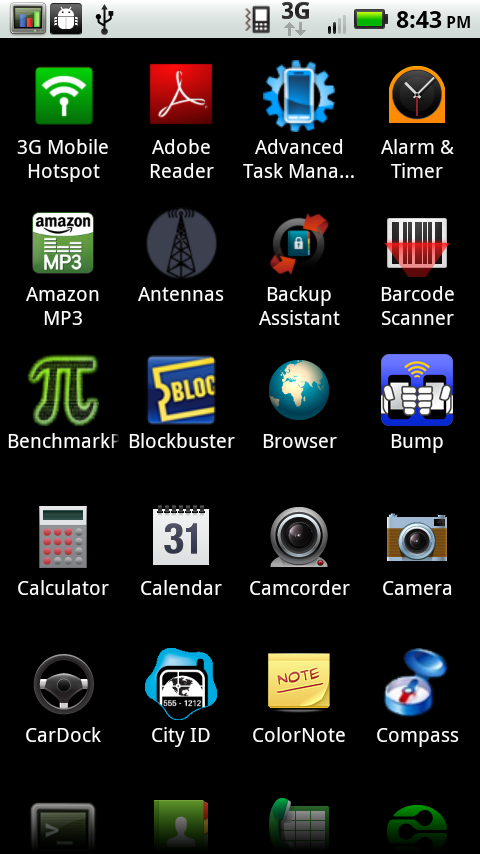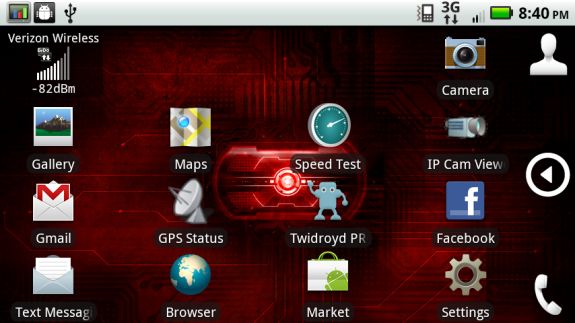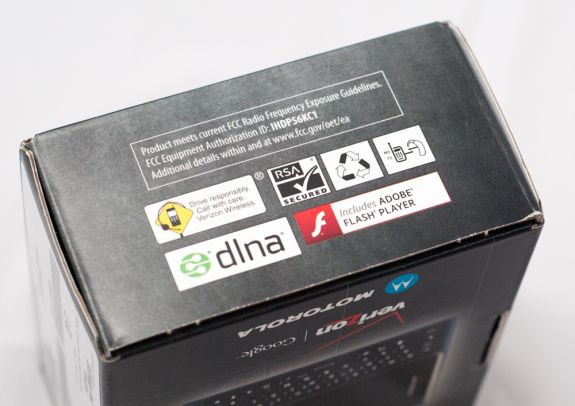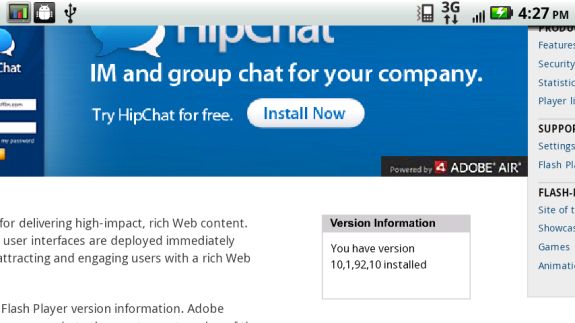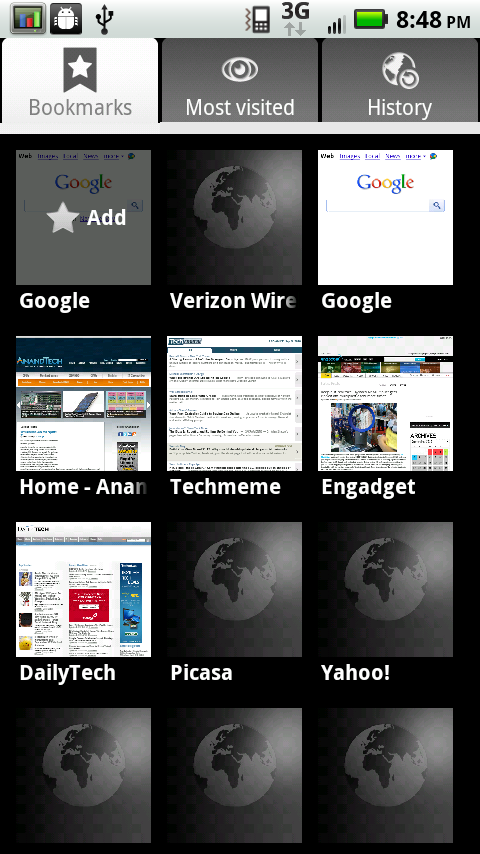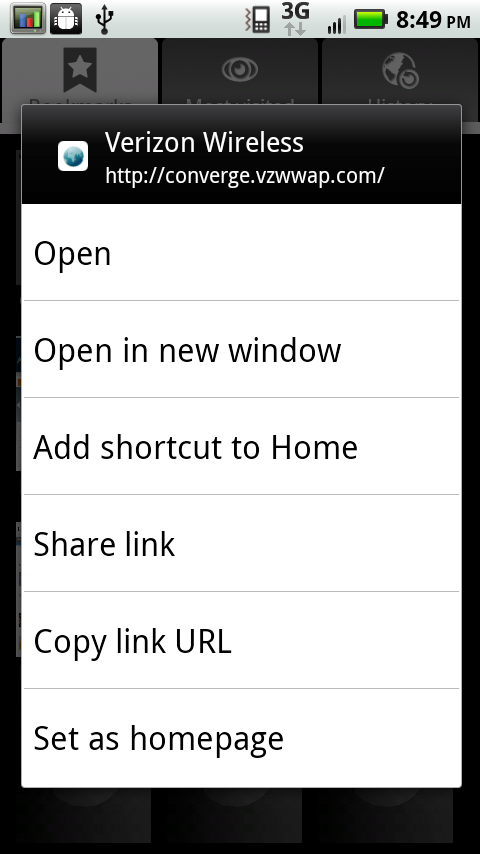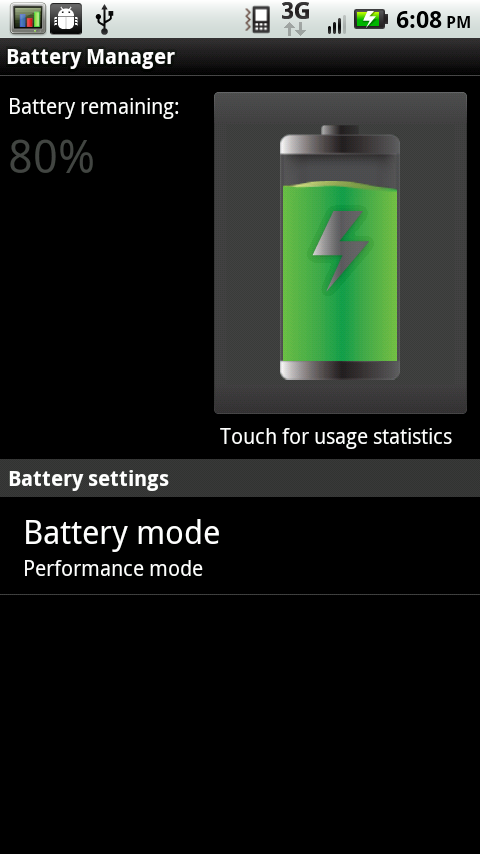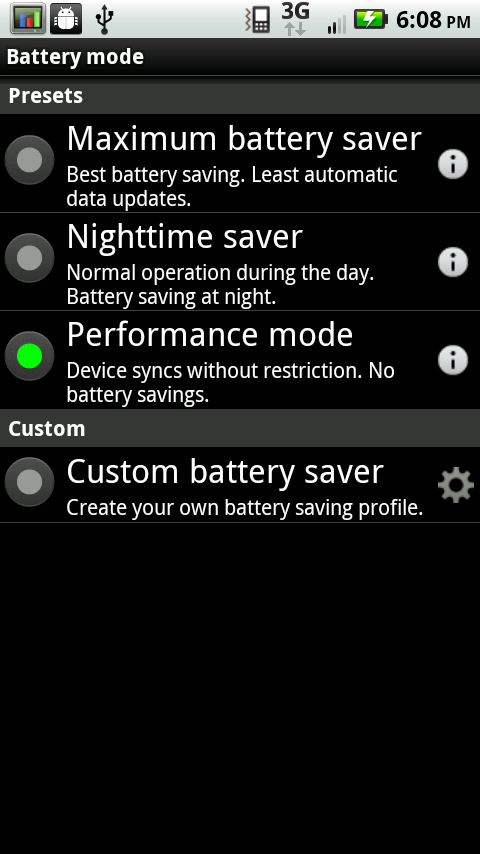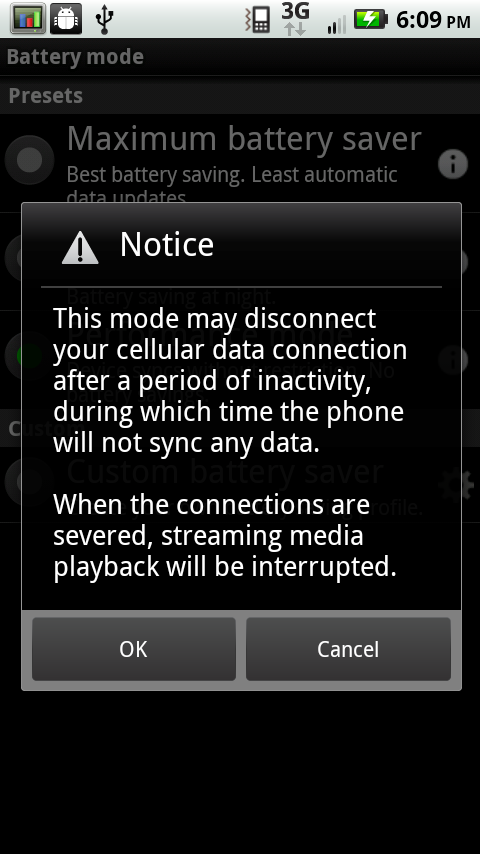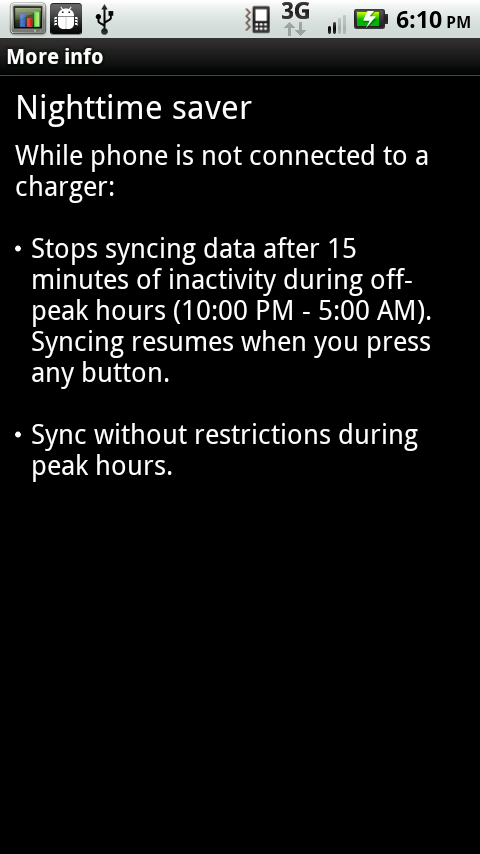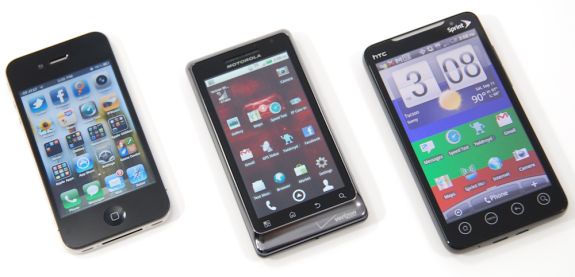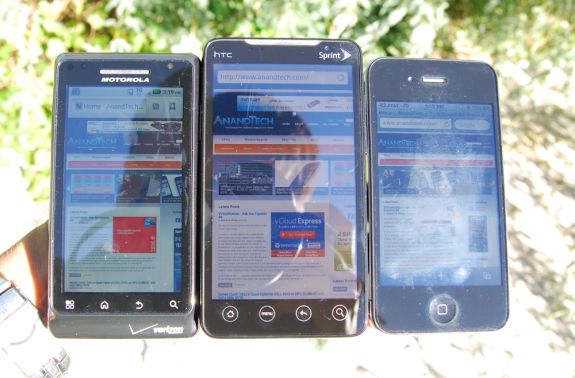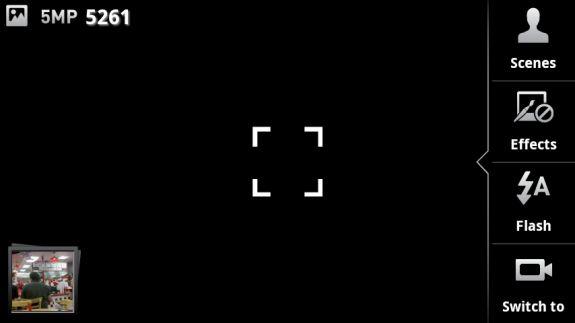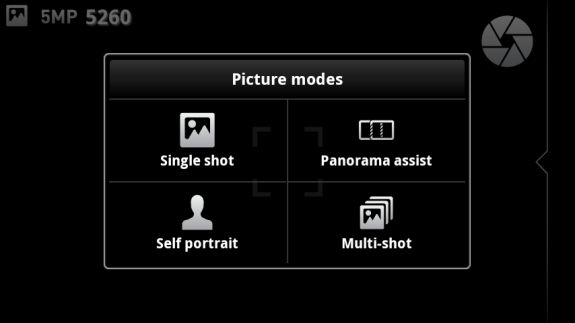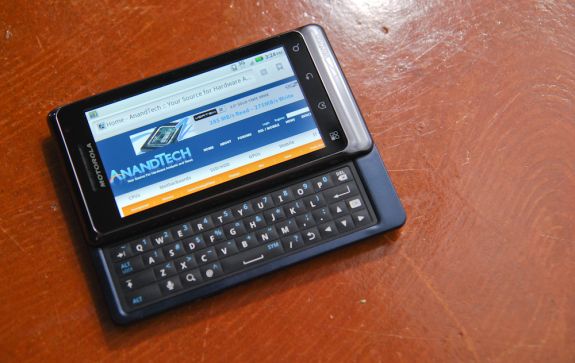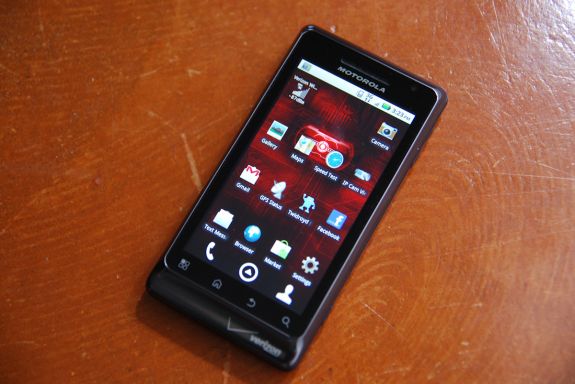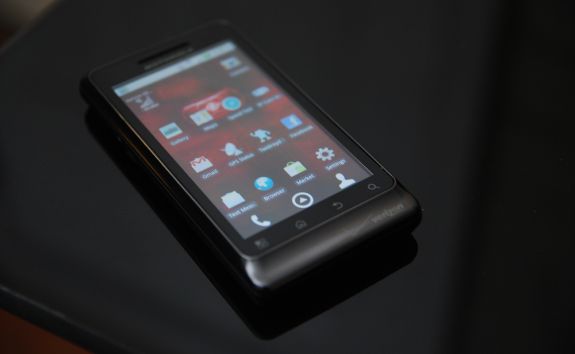
Original Link: https://www.anandtech.com/show/3908/motorola-droid-2-review-rebooting-the-droid
Motorola Droid 2 Review: Rebooting the Droid
by Brian Klug on September 19, 2010 7:00 AM EST- Posted in
- Droid
- Motorola Droid 2
- Smartphones
- Android
- Mobile
If you’ve played around with the original Motorola Droid, the Droid 2 will feel very familiar. In fact, at first glance, the Droid 2 appears almost identical to its predecessor—so much so that distinguishing the Droid 2 from the original in the hands of passers-by can be a bit of a challenge.
First off, the back of the device isn’t black anymore, it’s a deep navy blue. In fact, basically all of the plastic on the back is a deep navy blue soft touch material. I’m generally not a fan of soft touch backs, as they tend to rub off or discolor from hand grease after a few weeks, but the Droid 2 has done a pretty good job keeping its tack.
The other particularly striking aesthetic change is a dark chrome band running around the top edge of the display. It’s a deeper, darker kind of chrome than I’ve seen on a smartphone before, and gives the Droid 2 a classier look instead of the gaudy fingerprint magnet that chrome usually turns into.
The lip at the bottom is likewise gone, replaced with a tapering chrome slope. Honestly, this space is now somewhat wasted on the Verizon logo. The microphone that used to be here is displaced to the bottom of the device.
The other physical changes are subtle. The previously troublesome volume rocker has been replaced with a much more solid feeling one with less protrusion, and the hard to click camera shutter button also is gone. Both of these changes are perfectly executed—the shutter button is still two step, but now doesn’t require so much force that you change composition when pressing so hard.
Motorola has kept the same style capacitive buttons from the original Droid, and they work the same as the previous device's. What’s different is the placement.
I’ve already said my piece about this before in the Droid X review. What’s good is that the Droid 2 now has the same button order as said device. What’s bad is that it will no doubt be met with swearing and gnashing of teeth for a few weeks if you’re used to the placement on the original Droid. Hopefully things will settle down now and there will be some standardization. Hey, imagine how I feel regularly using 3 different layouts.
The back of the Droid 2 is essentially the same design, but different colors. The gold speakerphone grating is changed—it’s silver now. As I mentioned, the back is now a navy blue color soft touch material. The camera markings and glass/plastic cover have been moved around a bit, but the camera and flash assemblies themselves appear unchanged.
If you pop off the battery door, you’ll discover what lies underneath is basically the same as well. In fact, the Droid 2 appears to use the same BP6X battery the old Droid did, which is a welcome boon for old Droid users—you've now got a backup battery.
The microSD card slot is still not quite optimal, requiring you to slide your thumb along the top and press to get the card out. I strongly prefer press-click-eject designs as I’m constantly worried about breaking or scratching contacts. I guess Motorola doesn’t expect you to be taking the microSD card out a lot. Oh and the card is class 2, not higher performance class 6 like on the Droid X.
The only remaining subtle tweaks are up top. The power button is similar in shape and style to the other buttons, sporting a rounded top that blends into the case. It’s sometimes a bit hard to locate the power button by sliding your finger along the top of the case, but not impossible.
If you look carefully, there’s also a tiny notch right at the edge between the flat back of the device and the top—this is the port for an internal microphone for noise canceling. I’m a bit concerned this could get blocked with lint or grime. It’s seriously tiny.
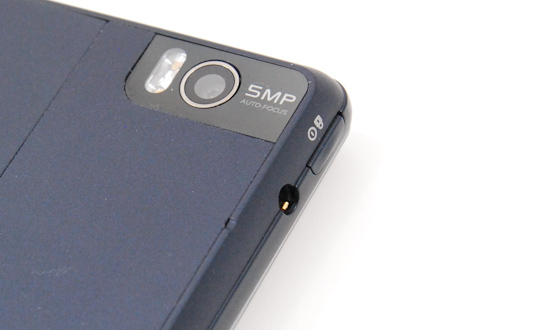
The phone is essentially exactly as slim as its predecessor, but still not super thin. You pay a price in thickness for getting that hardware keyboard (which is excellent—more on it in a second), but not a big one.
Lastly, the Droid 2’s packaging isn’t anything special or extraordinary. It’s similar to the packaging the Droid X came in, with the device in a nook at the right, and a flip up cardboard piece with accessories underneath. Motorola and Verizon aren’t going for flashy with the packaging, they just want to fit a heck of a lot of them in a box for shipping.
Finally, a usable hardware keyboard
Of course, what’s really changed about the Droid 2 is the keyboard. I reviewed the original Droid a while back, and talked a lot about why I found the first Droid’s keyboard frustrating to the point of being unusable. What I was missing however was perspective on the original Droid’s refreshed keyboard, which has somewhat raised keys, and thus much better feedback.
If you’re contemplating upgrading from the original device, just how much better the Droid 2’s keyboard will feel to you is purely a function of which revision of the original Droid you’re coming from. If you were an early adopter and got the first one, the difference is dramatic to the point of earth shattering. Most people I know with the first revision, concave-key sporting version don’t even use the hardware keyboard. However, if you’ve already got a later revision from hopping onboard later or RMA, the difference isn’t nearly as dramatic.

Motorola Droid (original) Keyboard
The oversized Dpad is gone, which is good for most things as it just didn’t serve much purpose in Android, but did have get use in some game emulators and other programs. Android developers are likely going to build interaction paradigms around whatever inputs are present on a majority of devices, and there just doesn’t seem to be a majority of Android handsets with Dpads or optical trackpads. You’re not totally screwed if you needed directional controls, however, as the Droid 2 maintains up down left and right keys in the bottom right. What’s really nice about the Droid 2 keyboard is that the space picked up from ditching the DPad has been put to really good use. The keyboard is arranged in an offset pattern just like a real QWERTY keyboard should be.
The domes themselves are also convex, just like they always should have been. Even better are raised bars on j and f for index finger placement—again, just like a real keyboard.
There are dedicated search, microphone input, back, and ok buttons as well. The result is that with the exception of home, all of the capacitive buttons are present in landscape mode as well. There’s alt-lock in the place of caps lock, which is a bit odd, but everything you’d expect is here.
The keyboard slider assembly is likewise unchanged from the original Droid. There’s no spring assist—just friction. There are thankfully two clicks for keeping the phone in the closed or open position, but nothing more. Sliding the tray open and closed is smooth, but not very.
After a week of use—greasy glossy back and scrapes from sliding mechanism
I don’t think anyone will complain about it, and don’t get me wrong—it isn’t a problem—but I’m left wondering why Motorola seriously couldn’t add two strips of Teflon to the slider and make it feel smooth as glass. HTC has done it forever.
As it stands, you can clearly see the slider assembly making marks on the glossy back of the display, which begs another question: why the heck is this so glossy? Regardless, the addition of some teflon would make the Droid 2’s slider rightfully feel like a piece of precision engineering or an expensive micrometer. Otherwise, it feels forced and a bit cheap. There’s also one or two degrees of oreo effect when the keyboard tray is closed. In the open position, the mechanism is completely solid.
The Droid 2's backlighting is adequate, but just a bit understated. I didn't have problems finding keys in the dark, but they're not super bright, just lit.
On the whole, the Droid 2 feels much the same as the original device. What’s different is that Motorola has worked out the few hardware oddities (like that chin at the bottom) and smoothed over the hardware’s rough spots. Literally smoothed over—the 2 has gracefully rounded edges along the outside and slightly longer radius curves in most others.
The result is probably the most optimal balance between ties to the old Droid and a much needed refresh.
Tons of Keyboard Options
There’s also a suite of input options on the Droid 2. Like the X, it comes with Swype preinstalled, along with the custom Motorola multitouch keyboard, the landscape hardware keyboard, and one more—SwiftKey. The SwiftKey install is still beta, so it ships turned off, but I like SwiftKey on the whole. It’s got a bit more word prediction intelligence, as it analyzes what words you use in the messaging app to get a bit more of a feel for your speaking habits.
The center box at the top is the word SwiftKey thinks you meant to type and will replace whatever you’ve typed with. The box at the right is its next best guess, and the box on the right tells SwiftKey that what you’ve typed is a new word, and not to correct it. Sometimes the suggestions are a bit frustrating, but as you use it and let it learn your, erm, vernacular, it gets better. I’m ashamed how predictable my SMS habits are.
But what about when you're typing a message with the hardware keyboard? Well, a minor frustration in the text messaging app in landscape is just how much space is wasted on extraneous information up at the top. You’ve got the status bar which is important, but down below it is a huge avatar space, name, and number.
Look at it, it’s 105 pixels tall! By comparison, the space you’ve got to actually read the conversation is 256 pixels tall. That’s nearly 30% of the space, absolutely wasted on information you already ostensibly know. An OTA update just a few days after I got the Droid 2 added the scroll assist bar on the right, which is welcome, but honestly there just isn’t enough space to read your average conversation. It can be a huge frustration.
I’m not being unfair to Motorola here either, folks. Look at the default landscape text messaging application organization on a Nexus One running 2.2:
The name and number are 37 pixels tall, the compose area is 316 pixels tall. That’s just over 10%. Of course, the tradeoff that Google has made is that they choose to show you the person’s avatar each message entry, just like some IM clients.
I know you can choose from a number of SMS applications from the market, but this is precisely the kind of thing that makes people hate UI skins. Moreover, it’s precisely the reason it won’t be allowed to happen in Gingerbread.
I’ve also continually encountered slowdowns with the SMS stack on Android devices (CDMA and GSM family alike across every device I’ve touched), and a number of my close friends have noted and complained to me about similar behavior. I’m not yet to the bottom of why this happens, but the Droid 2 seems fast enough that it doesn’t slow down nearly as often as I remember. I had three of my friends bombard me with SMSes all at once—in all, just north of 1,000 messages in a little over an hour—and the Droid 2 didn’t slow down. I suspect that Google hasn’t quite gotten vacuuming and defragmentation of the Android platform’s SMS SQLite database down perfectly.
More BLUR additions
We’ve already discussed the majority of Motorola’s BLUR-lite skin for Android in the context of the Droid X review. I thought that I wouldn’t see any more from BLUR, but I was wrong. Cleary not contented with how things turned out with the Droid X, Motorola has added a few extraneous things that for me push the Droid 2 a bit over the scale in my opinion.
First off, the default widget layout remains the same.
There’s stuff on every page, but thankfully you can remove them pretty easily. I still like that the Motorola widgets can be resized dynamically, however there’s just too many of them strewn about by default. It’s a matter of personal taste I guess, but don’t people like things to be clean and empty when they get them instead of already full of stuff?
Anyhow, what really gets me is what’s been added. Tapping on the up arrow to launch the applications list no longer results in an instantaneous presentation of applications. Instead, there’s a sporadically low FPS, choppy 1 second fade animation. Hit home to go back to the home screen, and there’s another 1 second fade animation. Go to settings -> display and set animations to “no window animations are shown,” and the second long blur animation will still happen every single time.
It sounds stupid, but it’s really these little extra things that are frustrating. Further, because they’re part of the BLUR UI, they don’t hook into the standard Android settings menus, which is why disabling all animations doesn’t do anything. It’s stuff like this that makes rooting not just a matter of choice, but rather a necessity for getting all this extra stuff out of the way.
Virtually everything else about the BLUR skin that I saw on the Droid X I see on the Droid 2. Probably the only notable change is that random extra animation, and landscape support for when you have the keyboard out.
Thankfully, you really can use the device with the keyboard out basically everywhere in Android, as everything first party has portrait and landscape support. Applications have to build their own landscape support in, but that’s how it is on all the major platforms.
Browser
The Droid 2 is the first Motorola Droid shipping with Flash preinstalled. It comes with 10.1.72.10 installed by default, which is the last beta build out on the market before 10.1 officially was finalized. Interestingly enough, there’s Adobe Flash branding right on the Droid 2 box.
You can update the device to the latest version of Adobe Flash, 10.1.92.10, by grabbing it from the market directly. Be warned though it doesn’t show up in the normal list of applications waiting to be updated from the downloads window, you have to seek it out yourself. Sam and I have been doing lots of flash testing and have an interesting story coming up—there’s no major difference between the Beta 3 build and this final version that we’ve encountered yet.
What’s different about the browser on the Droid 2 is in bookmarks. I noticed that you can’t delete either the Verizon or Google bookmark, which occupy the first and second spot in the bookmark menu. Try to delete them by long pressing, and you’ll get a dialog where deletion is suspiciously absent. You can't scroll up or down, it's just not there.
This isn’t just slightly annoying so much as it is unnerving. Do we really need a permanent bookmark to Verizon’s portal page, or Google? Moreover, what's open about forcing you to live with a useless Verizon bookmark you can't delete—without rooting? I’ll let you be the judge.
The rest of the browser is thankfully unchanged and just as great as it is on stock Froyo.
Cellular and WiFi Performance
There’s been a bit of discussion about whether the Droid 2 has signal and antenna issues a la iPhone 4. I was excited to get testing, and ran the Droid 2 through our now-regular tests to measure attenuation from holding the phone in different positions.
| Signal Attenuation Comparison in dB—Lower is Better | |||||||
| Cupping Tightly | Holding Naturally | On an Open Palm | |||||
| Droid 2 | 11.5 | 5.1 | 4.5 | ||||
| BlackBerry Torch | 15.9 | 7.1 | 3.7 | ||||
| Dell Streak | 14.0 | 8.7 | 4.0 | ||||
| Droid X | 15.0 | 5.1 | 4.5 | ||||
| iPhone 4 | 24.6 | 19.8 | 9.2 | ||||
| iPhone 3GS | 14.3 | 1.9 | 0.2 | ||||
| HTC Nexus One | 17.7 | 10.7 | 6.7 | ||||
The Droid 2 has just lower than average worst case signal attenuation when cupped deliberately near the antenna in the bottom of the device. Remember, less attenuation is better here. The Droid 2 therefore doesn’t have any problems that stem from the antenna itself, what then of the entire stack?
Remember that on CDMA cellular systems like Sprint and Verizon, voice and data are separate. Voice always operates over 1xRTT (which can also carry data, but at a slower rate with a maximum of 153 kilobits/s) and requires its own slice of spectrum. For faster “3G” data on a CDMA system, EV-DO is used, which likewise also requires its own slice of spectrum. This combination of two technologies from the same family makes most modern CDMA-based cellular systems hybrid in nature, and almost all CDMA handsets can only tune one (1xRTT or EV-DO) at a time. This generally isn’t a problem—most of the time, your CDMA handset polls a 1xRTT paging channel to check for an incoming call, notification, or SMS periodically. How often that happens is defined by the Slot Cycle Index (SCI) which can be anywhere from 1.28 seconds to much higher. Sometimes you can set this parameter yourself in engineering menus (the number corresponds to x^2 seconds), but you can’t exceed a number defined by the cellular system.
There’s a trade-off of course. Longer indexes will earn you a measurable battery life savings, but you’ll get less time to respond to an incoming call—the call will ring until your phone polls and picks it up. Shorter indexes will notify you of calls much more quickly, but drain battery faster.
Android does a good job hiding this all away from the user. In fact, there’s no way to change the SCI on the Droid 2—whether you have access to an engineering menu where you can tweak those things is entirely up to the manufacturer. The Droid Eris, HTC EVO, and Galaxy S phones, for example, have a suite of engineering menus.
I rarely see the 1x symbol pop up even when texts are coming in (despite the fact that it actually is on 1x to receive SMS), and most applications gracefully wait and resume. However, it sometimes still does happen that things don’t work perfectly, and you’ll transact data during this period and get stuck on 1x for a while. That’s actually pretty normal, and I see it all the time on a variety of CDMA devices. On the whole, this data handover has gotten much faster, but there’s still a period where the phone will wait before starting a data call on EVDO after initiating one on 1x. Generally the longest this takes is 3 seconds. But after you’re on 1x, if you keep transferring data, you won’t hop back to EVDO—on every CDMA device I’ve ever used, that only happens when data is idle.
Cellular and WiFi—Continued
But there’s something else too I believe led to confusion. Motorola has built on the power saving menus and extras they bundled with the Droid X, and the shipping configuration is much more conservative. There’s an extra entry in the settings menu named Battery Manager:
Go inside, and you’ll get a big battery indicator, percentage, a shortcut to see the battery use display Android provides, and something else. Down below is ‘Battery mode’. By default, there are three configurations, and Nighttime saver is selected. Let’s see what it does:
Motorola is basically opting to let you set a schedule for when it should use battery to keep data connections alive. Generally they’re always active, and ready to be used. However, chances are good—if you have a normal sleep cycle—that you won’t use data between sundown and sunrise. Honestly, 10 PM is a bit early for me, as is 5 AM. I won’t even say what hours I’d probably put in here, but basically nothing data is going to happen between these hours by default. Even during setup, there’s a prompt that basically states this has been selected.
You can define your own under custom as well. However if you want the Droid 2 to behave like any other smartphone, select ‘performance mode.’ These titles are somewhat misleading, as none of the three settings appear to actually change system performance—I can still make the Droid 2 run at 1 GHz with load. That behavior remains unchanged. What does is whether the Droid 2 will initiate a data session or sync your accounts.
There’s some benefit to turning data off at night, but only if you don’t regularly plug your phone in before bed. If you’re a smartphone user, you’re probably already in that routine.
I think the introduction of this feature created the primary source of confusion, specifically allegations that data isn’t working as it should be on the Droid 2. I ran just over 100 speedtests on the Droid 2 and averaged 0.715 megabits/s down, and 0.620 megabits/s up on Verizon’s 3G network. The maximum I saw was 2.373 megabits/s down and 1.318 megabits/s up standing about 100 meters with line of sight to a VZW cell tower.
A Lukewarm Hotspot
I didn’t ever have problems with data accessed on the Droid 2 itself. Where I did have massive problems was with tethering on the Droid 2’s built in 3G Mobile Hotspot. Like the Droid X, the Droid 2 has pretty much the same icon and application. In fact, as appearances go, the thing is exactly the same. The difference is that on the Droid X, it worked.
On the Droid 2, my experience was all over the place. I’ve struggled with the Droid 2 hotspot constantly. The problem is that it will just stop working entirely. The hotspot service will pop up with “3G data connection lost”—and the entire hotspot will turn off. It's maddening, every time I was on the go and trying to use the hotspot, I either lacked a USB cable or wasn't quick enough to capture the "3G connection lost" error. It happens so randomly that predicting when the connection is going to drop is nearly impossible.
What’s strange is how sporadic the behavior is. Sometimes the connection will last a solid hour, and be just fine, other times it’ll barely work for 5 minutes. I tested in excellent signal areas, poor signal areas, and with the Droid 2 forced on EV-DO data (no polling of 1x) and forced 1x (slow 2G data) through the *#*#4636#*#* engineering menu—it still drops randomly. I tried all of my laptops and mobile devices, and even swapped through no fewer than three miniPCI-E wireless NICs—it still drops.
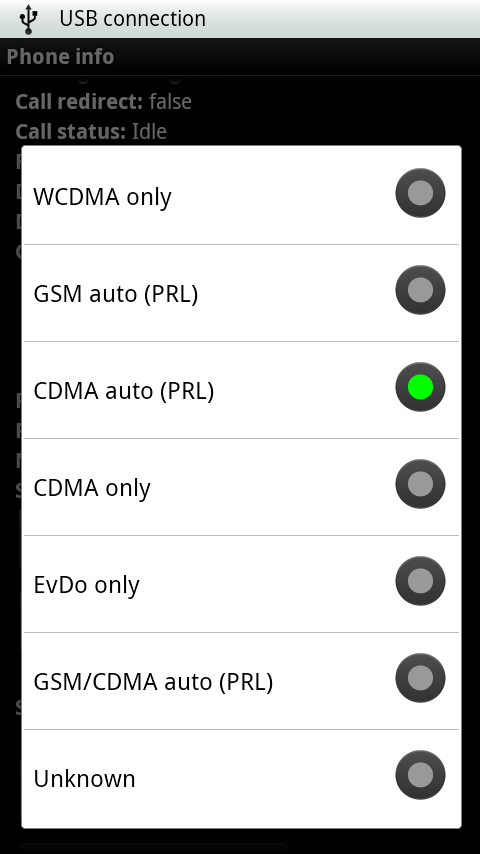
This feature is basically broken on the Droid 2. There’s just no other way to state it. If you’re getting the Droid 2 for the built in 3G hotspot feature, reconsider until Verizon and Motorola address it with an OTA update. Or use one of a number solutions from the market, or root. Either way, this was disappointing for me.
Typical WiFi Performance
WiFi performance on the Droid 2 is unsurprisingly on par with the Droid X, as it should be. I saw the Droid 2 negotiate a 65 megabit/s link with a 2x2 802.11b/g/a/n router of mine, which is common for smartphones as we’re starting to see.

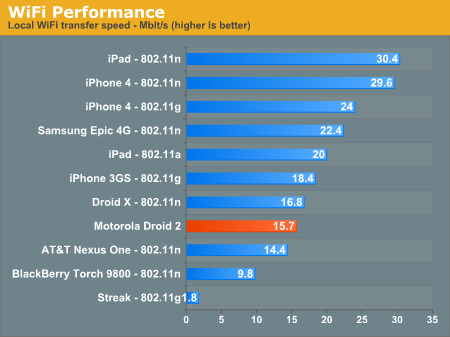
GPS is also something a lot of people mentioned regarding the first Droid. When I played with one, I never had fixes take very long, but others did have problems. The Droid 2 thankfully had no issues while testing.
Cold fixes were always speedy as expected. I don’t think anyone will complain about the Droid 2’s GPS performance in all honesty. As always, having WiFi turned on will help get an initial location and speed up the fix, and do a much better job locating you indoors.
The Display
The Droid 2 uses the same 3.7” 240 PPI IPS screen as the original Droid. In fact, the front of the device seems almost unchanged. The panel is the same, as is Corning gorilla glass. I measured the original Droid and found the display very contrasty and very high PPI due to the smaller size. Again, Motorola uses a relatively unique 854x480 resolution where the norm appears to be 800x480 for most other Android 2.x devices.
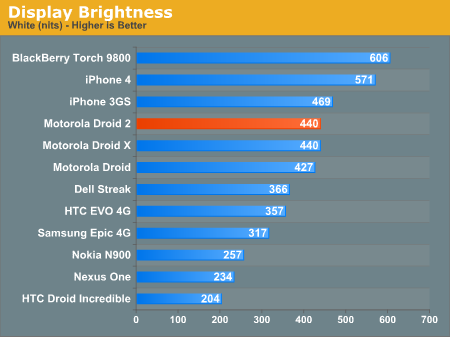
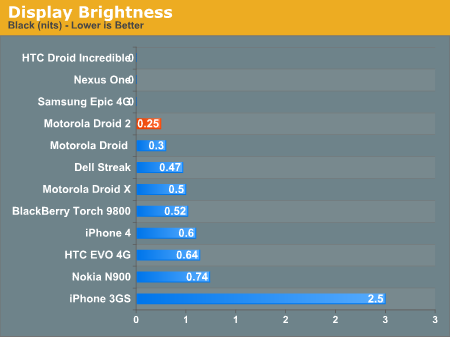
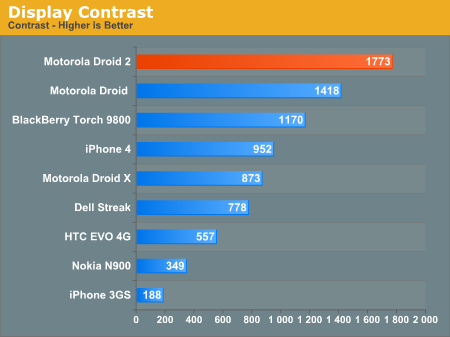
The Droid 2 edges out the original in black point and contrast. Keep in mind this measure is at maximum brightness with the backlight all the way on.
Since the Droid 2 isn’t AMOLED, it’s quite readable outside. I haven’t yet passed judgement on how it stacks up against Super AMOLED, but Anand is pretty certain readability is close.
Finally viewing angles and hues are up. The Droid 2 seems to have a slightly warmer hue than I’m used to, it’s a bit obvious when displaying white and comparing to other Android devices or the iPhone 4. I’m not certain which is more true to color, but just be aware. As for viewing angles, the Droid 2 surprised me by not being one of the best.
Turns out the EVO is actually strikingly viewable at extreme angles. There's not much more to say about the Droid 2 display that we haven't already said about the original Motorola Droid—it's the same display and the same glass on top. See the gallery for more shots.
Performance on the Droid 2
The Droid 2 also uses an OMAP3620 series SoC, similar in nature to the OMAP3630 used in the Droid X. The OMAP3620 and OMAP3630 are both ARM Cortex-A8 based, and clocked at a maximum of 1 GHz. Both share the same PowerVR SGX 530 GPU at the same clocks.
Where the OMAP 3620 differs is in video encode and camera capture support. The OMAP3630 is capable of HD 720p video capture and playback, along with support for camera resolutions above 5 megapixels—this makes the SoC the clear choice for the Droid X, which has a higher resolution camera and unsurprisingly supports 720p video encode. The OMAP3620 in the Droid 2, however, only supports up to SD DVD (720 x 480) video capture and playback, and up to 5 megapixel camera capture.
The reason why 720p video encode isn't present with the Droid 2 is now pretty obvious—SoC support isn't there. The rest of the platform is the same—you get Cortex A8 at 1 GHz, the SGX 530 graphics and the rest of the OMAP36xx platform the Droid X has that made it very quick in our benchmarks. The Droid 2 surprisingly has DDR3 onboard (not to be confused with LPDDR3—OMAP3630 and OMAP3620 support LPDDR1 at up to 200 MHz).
Performance is thankfully relatively speedy, as long as you’re not considering that strangely slow applications menu fade animation. Surprisingly however, the Droid 2 doesn’t post numbers in line with how fast Snapdragon 1 GHz parts with 2.2 are posting in a number of areas. Linpack is probably the most interesting:
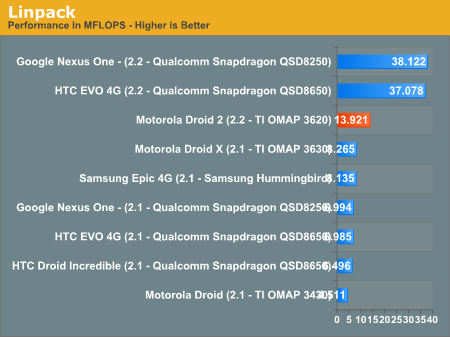
I’m uncertain about whether the issue lies with Motorola’s 2.2 install on the Droid 2, but hopefully the X doesn’t suffer the same kind of oddities. Back on 2.1, OMAP3630 in the Droid X packed a fairly decent lead CPU wise whenever we could measure it, so hopefully this is an issue with the JIT compiler or something else simple that will be fixed.
Interestingly enough, browser performance is right where it should be on the Droid 2 with Froyo, scoring just a bit behind the Nexus One.


GPU benchmarks remain OMAP 3620’s strong point, with the OMAP 3620 in the Droid 2 posting Neocore and kwaak3 numbers in line with what we saw with the Droid X. That’s how things should be here, too:

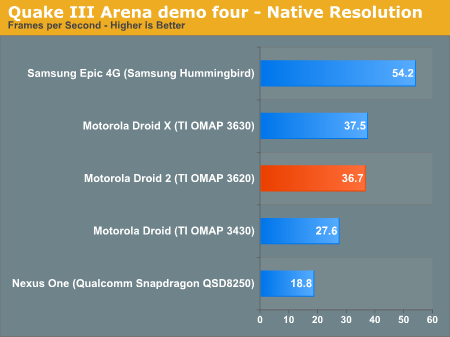
The move to 2.2 or the 3620 (from the Droid X's 3630) doesn't really change those scores at all. It'll be interesting to see if Droid X Froyo performance is in line with the Droid 2 or if other hardware differences make it slightly faster.
Speakerphone Comparison
We’ve been testing speakerphones regularly on devices, specifically volume numerically using a decibel meter and audio quality subjectively. The Droid 2 is sufficiently loud at maximum volume on speakerphone.
I was surprised, but there’s actually a bit of distortion and saturation at maximum volume. Taking it down one notch results in much better sound quality and no distortion. Nothing rattles around at maximum volume, it just sounds like there's definitely some saturation.
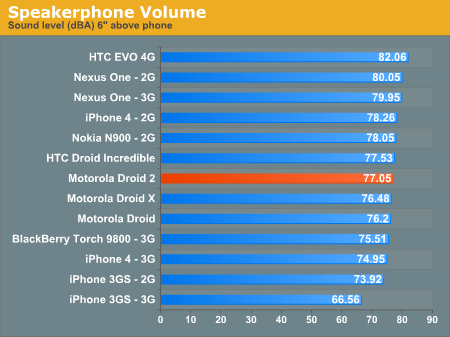
As was the case with the old Droid, the speaker is on the back of the device under the silver (previously gold) grating. Thankfully there’s a raised portion which creates a small channel for that sound to come out the sides. It’s still quite loud even face up as we’ve shown. Handset voice quality is par for CDMA 1x voice.
Camera
About the only unchanged thing on the new Droid 2 is the camera, which inexplicably is the same 5 MP resolution as its predecessor. I wasn’t hugely impressed with the shots that camera produced on the first Droid, nor its interface, but the Droid 2 seems to have mitigated some of it in the software. What has changed on paper is video recording quality—we’re up to 30 FPS from 24 for that SD DVD quality 720 x 480 video. Again, 720p capture is missing because the Droid 2 has an OMAP3620 versus the OMAP3630 in the Droid X.
The first gallery is our bench, which is becoming difficult to ensure stays the same due to changing weather and lighting—which is the reason we've added those controlled lightbox tests.
I noted in the BlackBerry Torch review that I’m going to do more controlled testing with uniform testing in a lightbox, in addition to bench photos. I’ve done the same with the Droid 2, and if you looked, you’ve already seen the shots it produces. Many of you asked for a DSLR pic in the box as well, I've added shots from my D80.
The Droid 2 by default still produces pics that are a bit undersaturated, but not nearly as much as its predecessor. Where it does shine though is using the flash—it’s hard to argue that the Droid 2 doesn’t have the most uniformly lit photo of the bunch.
The Droid X included an interesting and occasionally awesome camera software stack. Essentially everything from that camera application is also ported to the Droid 2.
The only things that are missing are the microphone noise canceling options, and 720P video. Everything else—including the awesome panorama mode—is there. Camera capture is roughly the same speed as it is on the Droid X.
Video Capture
Finally we've got our video tests. The Droid 2 captures video in H.264 video and AAC audio at an average bitrate of 550 kBps in our video. As I mentioned before, it's difficult to control light at the test location. Video capture on the Droid 2 actually is pretty good, and 30 FPS versus the original Droid's 24 makes a visible difference. This section is starting to get a bit unwieldy large, eventually we'll craft a nice switcher for easy comparison.
Motorola Droid 2
BlackBerry Torch 9800
Motorola Droid X
HTC EVO 4G
Nexus One
iPhone 4
HTC Droid Incredible
Motorola Droid
Nokia N900
Running battery life tests on smartphones has become such an engrained part of my routine that I actually completely forgot to include this section when I hit publish the first time. When I'm not testing features and out running speedtests, these phones are either charging or under battery life test. Thanks for bearing with me.
For the 3G and WiFi page loading tests, we use a set of 3 dozen or so webpages that are loaded every 20 seconds continually with the backlight set at 50%.
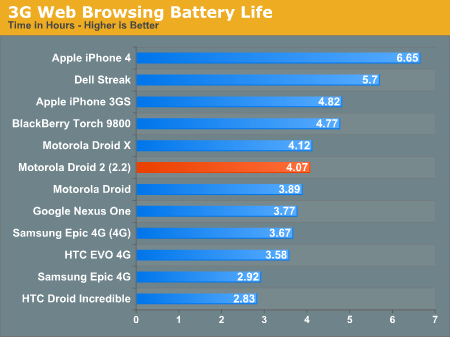
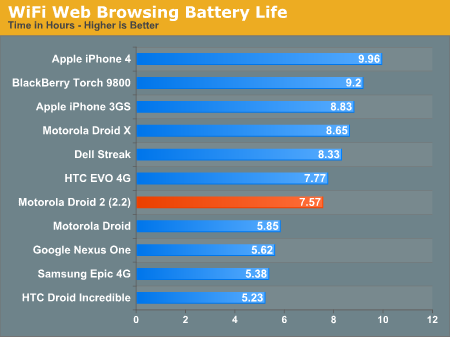
The Droid 2 improves on the original Droid when it comes to WiFi pretty substantially, but doesn't really change that much on 3G cellular.
Where the Droid 2 shines, however, is call time:
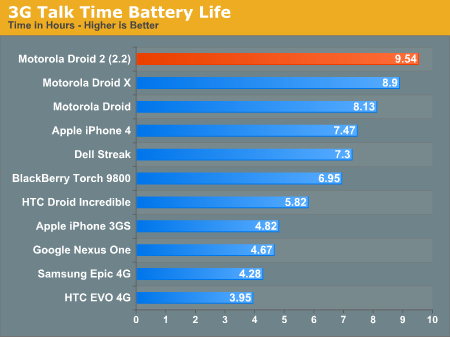
That pretty much says it all. Look at the top three phones—Motorola is doing something special to keep their phones cranking out impressive talk time battery life. Whatever it is, it works on the Droid 2 like it does the X and original Droid.
Conclusions
The Droid 2 is obviously incremental—look no further than the name. But even nailing incremental product refreshes can be hard, and Motorola has largely done it with the Droid 2's excellent hardware. The masculine industrial design of the first still shines through on the Droid 2, and the hardware itself retains what was great about the form factor without changing everything needlessly.
For the most part, virtually every major complaint about the first device has been addressed, and for that Motorola deserves credit. The D-Pad is gone, the keyboard is completely revamped for the better, troublesome buttons refined, awkward chin tucked away, and the platform's SoC has been updated. The device hardware itself is thoroughly modern with the exception of the camera stack's inability to record 720P video.
Though the Droid 2's hardware is unequivocally excellent, the software still needs tweaking. There's absolutely no doubt in my mind that 3G tethering needs some major attention, and performance in some areas just isn't where it should be. Hopefully all of this can and will be addressed with a timely OTA update. There's also the matter of Motorola's BLUR skin, which there isn't any way to turn off short of rooting and loading a different ROM.
If you're an existing Motorola Droid owner, the Droid 2 will feel like almost completely familiar territory. Quite honestly, unless you're absolutely dissatisfied with the speed of that device, the Droid 2 will feel exactly the same. The differences lie in the keyboard, and whether you'll have the 'Wow' moment I did will depend entirely on which original Droid keyboard you ended up with.
If the original Droid was a slightly insecure adolescent that made up for being the newcomer with brash masculine boasting, the Droid 2 would conversely be a much more confident polished 30-something. It's still hip, but there's nothing earth-shattering about the whole package this time around—it's just a safe update. If you've got the original Droid, the Droid 2 just isn't quite enough of a huge leap forward to warrant an upgrade unless you really need the speed. Faster performance will come late 2010 and early 2011 in the form of ARM Cortex-A9 MPCore based devices running at even faster clock speeds. That said, if you're in the market for an Android phone on Verizon with a keyboard, look no further than the Droid 2.

